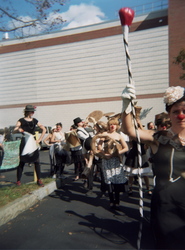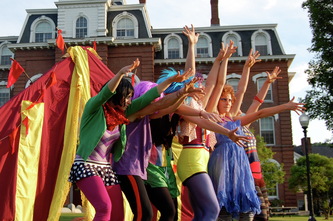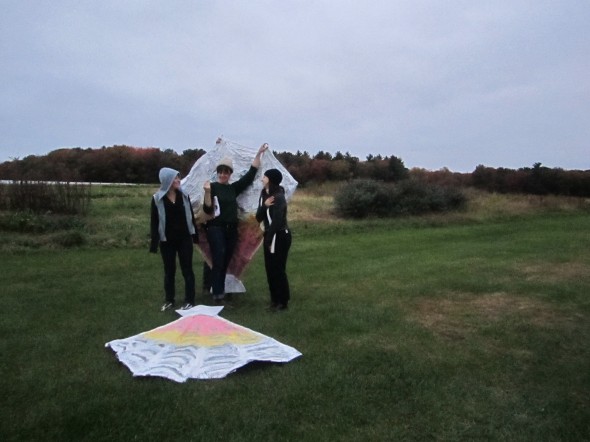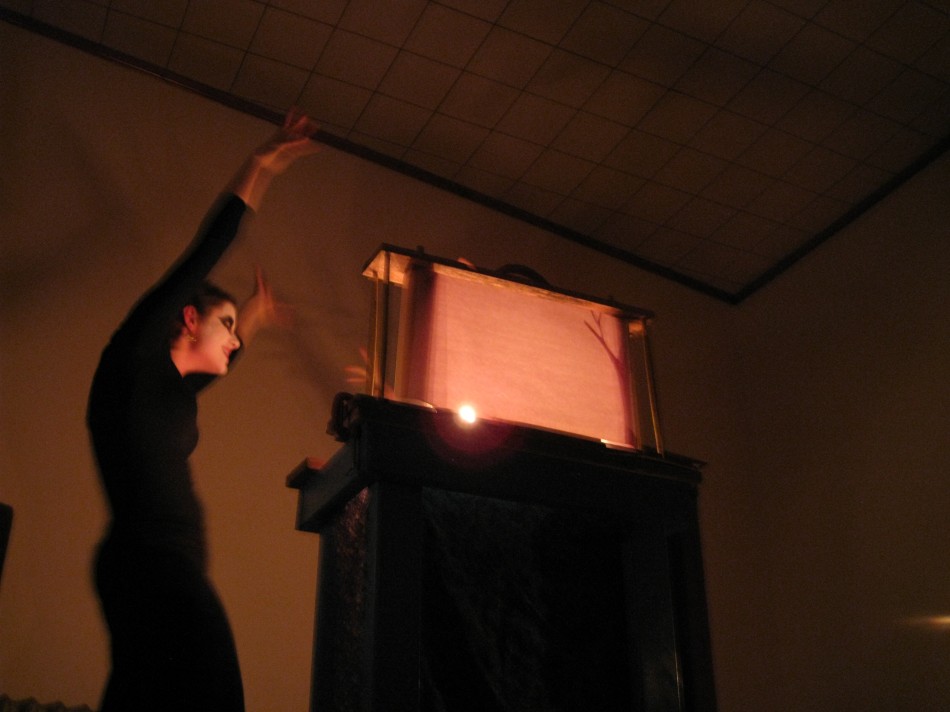We are living in a strange world, in strange times, and in it are many strangers. But lucky for us, there are people like Sophie Wood who illuminate, activate, and celebrate our strangeness, and help us find friendliness in the face of the unknown.
Sophie is an artist, organizer, director, dancer, farmer, puppeteer, cook, musician, seamstress, builder, mover, shaker, mask-maker, actor, clown, gardener, designer, cheerleader, sculptor, activist, dreamer, and all around great gal who makes wonderful, magical things happen every day, in all sorts of different ways. Among many other things, she is the director of The Royal Frog Ballet and a driving force behind events such as the wildly popular annual Surrealist Cabaret and Pumpkin Walk, The Busker’s Ball, and the Chelsea “Get Thee to the Funnery” Summer Shakespeare Camp.
I’ve always crushed really hard on Sophie, and the more I get to know her and work with her, the more impressive she becomes. Sophie is a masterful organizer whose resourcefulness, open process, and trust in others results in very special events. She creates opportunities for artists and performers to take risks, and leads by fiery example. Her love for the community she works in is apparent in the shape and content of her work. She possesses a wild imagination, seriously passionate pep, down-to-earth coolness, and real humble grace.
It is my sincere pleasure to share with you the work and words of Sophie Wood.      – Haley Morgan
 What are you trying to communicate or explore with your work?
What are you trying to communicate or explore with your work?
I’m trying to explore and express and find a shared experience with those around me about how it feels or what it means (and maybe it means nothing!), to trudge through the dark murky muck of the human experience mixed with the delight of being alive and ready and open to the strange and magical mysteries of the universe. I’m not trying to communicate a specific idea so much as a feeling: Eliciting delight, (a feeling of joy, surprise, recognition, the unexpected and unknown, maybe even fear, crude happiness: the kind that bubbles up from the belly), and finding commonality are my main goals when making work.
In making work I like to ask and explore: How to laugh at myself, and invite others to laugh with me. How it shake it in an imperfect body, in an imperfect world, and shake it like I mean it. How to be inviting and challenging at the same time. How to feel satisfied and full and fresh. How to hold irreverence reverently. How to make magic happen. What’s the good story that keeps resurfacing?
Where were you when you created one of your favorite works?
Ooo, that’s hard. Everywhere! Anywhere! Space is one of the main elements that I plan pieces around, and creating good spaces in life is an art form that I like to cultivate (cozy kitchens! Beautiful gardens!). I like the absence of a fourth wall, the inclusion of the environment as a participant in what the piece looks like and communicates, how the audience will feel in the space. I consider place or space a collaborator.
In my own living room, performing puppets by candlelight while we served tea and cookies to an audience sprawled across couches and mattresses while they sang lullabys to each other.
In my back yard, on my hands and knees, covered in clay and glue and dirt and staples.
On the farm. In a leotard and wig on the town commons of Vermont.
In the garden, making a bouquet.
At the kitchen table, while life and food carried on around me, art in the mix of the stew pot.
On the streets of Somerville in a clown nose holding a silent tuba, or the streets of Salvador, in circus pants, or the streets of Castleton with a samba drum, or the streets of Northampton in sequins and silly shoes, or the streets of Chelsea, rehearsing the death scenes in Hamlet, or any street, or green or backyard that I’ve gotten the opportunity to be with a big group of cohorts, collaborators, and playmates to use costumes and bodies and props and music and food to color outside the lines of everyday life and celebrate being alive.
How do you see your art in relation to cultivating community and how does community affect the work you make?
It’s nearly impossible for me to point to some work that I’ve made in the last several years and say “I made that, alone.†I make work with other people so intensively that I can’t see the lines where my art ends and theirs begins. Organizing and gathering people is part of who I am and how I move through the world. Feedback, collaboration, encouragement, brainstorming, and just plan old group muscle power is how I am able to make the work that I want to make. Being part of something larger than myself helps me to create work that comes from a deeper experience than just my own. I rely on having a community (artistic and otherwise) to help me stay positive about my work, pursue it more mightily, and recognize its merits in the world.
 Therefore, it’s necessary for my art making to be out in the world cultivating community: meeting people, making and maintaining connections with friends, doing collaborative work, supporting other people’s work, and also engaging with my community in ways that don’t have to do with art. I think that being part of a community takes work, it takes engagement, it’s not a given, it’s a gift that comes with a responsibility to maintain. In order to be a responsible artist I try to stay aware of what’s going on locally: in politics, in art, in business, in how the public spaces are operating, in the land, in the weather, in the local economy, and contribute to what’s happening (or not happening) in the ways that I can. I think that art made through this kind of engagement and offering resonates more with a community, because it is informed by and placed in the a local context, it includes the thoughts and words and ideas of the people around you, it becomes more dialogue than monologue.
Therefore, it’s necessary for my art making to be out in the world cultivating community: meeting people, making and maintaining connections with friends, doing collaborative work, supporting other people’s work, and also engaging with my community in ways that don’t have to do with art. I think that being part of a community takes work, it takes engagement, it’s not a given, it’s a gift that comes with a responsibility to maintain. In order to be a responsible artist I try to stay aware of what’s going on locally: in politics, in art, in business, in how the public spaces are operating, in the land, in the weather, in the local economy, and contribute to what’s happening (or not happening) in the ways that I can. I think that art made through this kind of engagement and offering resonates more with a community, because it is informed by and placed in the a local context, it includes the thoughts and words and ideas of the people around you, it becomes more dialogue than monologue.
When I was in college, I was studying theatre for social change, and making a lot of work with political or educational themes in the work, and thinking that that was the change: that I was going to tell the people how it should be, what the right way was, and then they would listen and things would change. HA! At some point (thankfully) I thought “who am I to know  or say how it should be, what ‘right’ is?â€
or say how it should be, what ‘right’ is?â€
I realized that the ‘social change’ that I was more interested in was the gathering of people together and using performance as a place to create dialogue, not a place to listen to dialogue. The ‘social’ in ‘social change’ was the change that I was really interested in, and I think that ‘change’ comes out of the dialogue that the ‘social’ aspect creates: a show or an event can create the jumping off point for conversation or be the place where conversations happen. So, I think a lot about the audience’s experience when making a performance: how will they feel sitting or standing? Will they need a snack or an extra layer? Can they see and hear in the way that I want them, too? Do they feel included? Are they in ‘the world’ of the performance or simply spectators on the outside? Have I surprised them? I like to call what I do “events†rather than performances, because my goal is to include the audience in the whole shebang, and not just have them participate by spectating. As often as I can, I include time at the end of each event for a talk back. I want to include the audience’s voices as much as I want to include my own.
 What is your spirit animal?
A wolf. I’m mangy and scruffy and like to go loping off in to the woods alone or look at you like I’m going to bite your hand off, but  at the end of the day I just want to howl at the moon and sleep in a pile with my pack.
at the end of the day I just want to howl at the moon and sleep in a pile with my pack.
What places in and around Northampton are you most curious to see inside of, or to make work in?
I want more busking on the streets of Northampton, particularly buskers besides just musicians, and more group busking! More sidewalk parades! More art and project making on Main Street! I’d love to make work on the bike path or in the enormous empty parking lot on King Street (dreams of a huge community garden, or an oversized night time puppet opera under the looming parking lights).
What are some strategies you use to sustain your creative practice?
Making sure to go out in to the woods regularly. Moving and using my body regularly and vigorously. Growing and tending a garden. Sleeping well. Eating like a queen. A steady diet of pop music. Wearing costumes on ordinary days. Not taking “No†or “That’s not how it works†or “Usually it’s done like this…†or “I don’t think that’s a very good idea†or “You’re never going to make money doing that†for an answer. Using any media that I feel drawn to in order to express what I want, regardless of my knowledge or training in a particular art form. Making routines. Jumping in over my head. Listening carefully. Only working paying jobs that I love and learn from.
And above all else: Collaborating
 What 5 things do you always carry with you?
What 5 things do you always carry with you?
A tiny notebook, (the butterfly net for genius), enough change for a cookie (to ward off starvation in case I get stranded), water (to avoid dehydration, see: stranded), calendar (for life planning at any moment), an extra layer (for costume changes).


